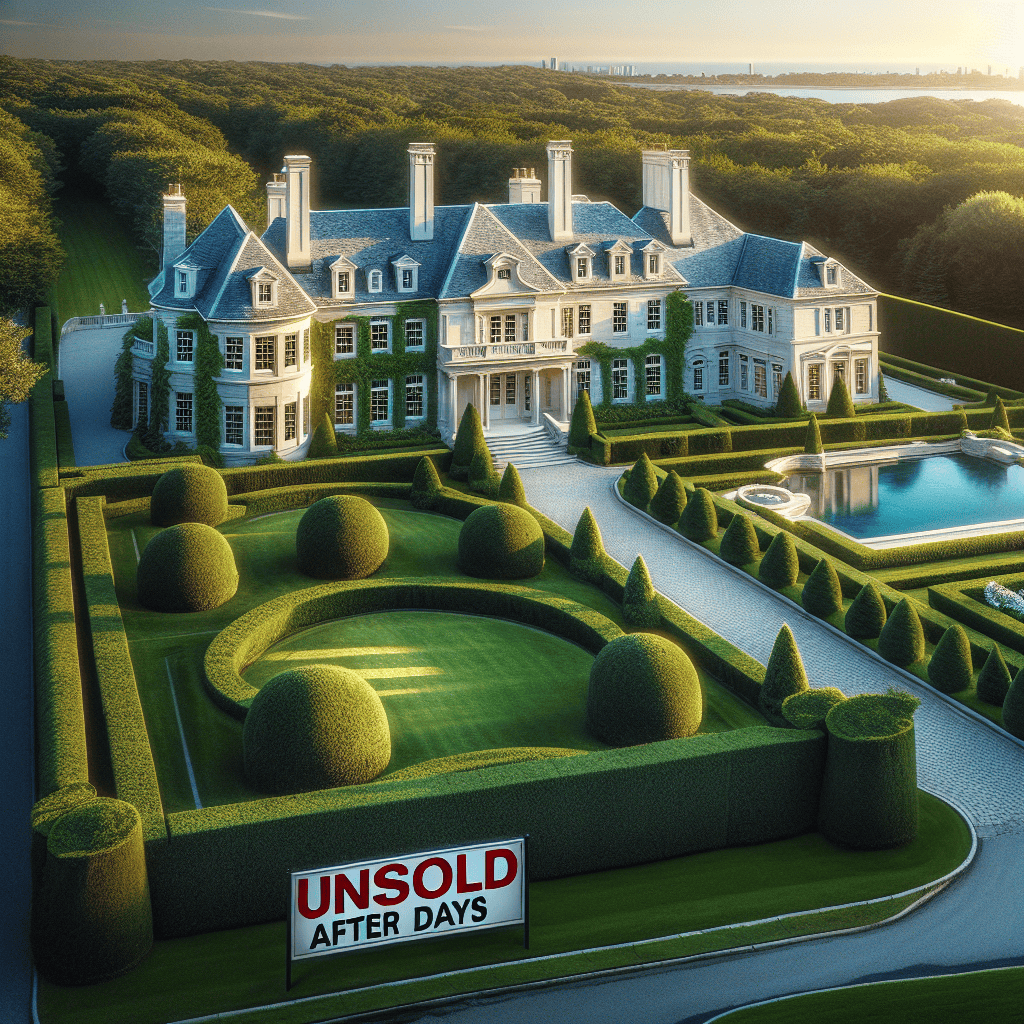“Luxury Meets Limbo: The $68M Estate That Even J. Lo and Ben Can’t Seal the Deal On”
Introduction
Jennifer Lopez and Ben Affleck’s $68 million estate has captured significant attention in the real estate market, yet it remains unsold after 100 days. This luxurious property, located in the prestigious area of Los Angeles, boasts an array of high-end features and amenities that reflect the couple’s glamorous lifestyle. Despite its allure, several factors may contribute to its prolonged time on the market. These could include the high price point, which limits the pool of potential buyers, market conditions that may not favor luxury real estate transactions, or specific buyer preferences that the property does not meet. Understanding these dynamics is crucial in analyzing why such a high-profile estate has yet to find a new owner.
Market Trends: Understanding The Current Real Estate Climate
In the ever-evolving landscape of real estate, the market’s dynamics can often be unpredictable, even for high-profile properties. A prime example of this is the $68 million estate owned by Jennifer Lopez and Ben Affleck, which has remained unsold after 100 days on the market. This situation provides a unique lens through which to examine current market trends and the factors influencing the sale of luxury properties.
To begin with, the real estate market is currently experiencing a period of fluctuation, influenced by a variety of economic factors. Interest rates have been on the rise, leading to increased borrowing costs for potential buyers. This has resulted in a more cautious approach from investors and individuals alike, particularly in the luxury segment where the financial stakes are significantly higher. Consequently, properties that might have been snapped up quickly in a more favorable economic climate are now facing extended periods on the market.
Moreover, the luxury real estate market operates under its own set of rules and challenges. High-end properties, such as the estate owned by Lopez and Affleck, cater to a niche audience with specific tastes and requirements. The pool of potential buyers is inherently smaller, and these individuals often have a plethora of options at their disposal. As a result, even the most exquisite properties can linger on the market if they do not align perfectly with the desires of this discerning clientele.
In addition to economic factors, the location and unique characteristics of a property play a crucial role in its marketability. The estate in question, while undoubtedly luxurious, may not align with the current preferences of high-net-worth individuals. Trends in luxury real estate have been shifting towards more sustainable and technologically advanced homes, with buyers increasingly prioritizing eco-friendly features and smart home technology. If the estate lacks these modern amenities, it may not appeal to the contemporary buyer, further complicating its sale.
Furthermore, the public personas of Lopez and Affleck, while generally advantageous in terms of publicity, can also introduce an element of unpredictability. Potential buyers might be deterred by the attention that comes with purchasing a property associated with such high-profile figures. Privacy concerns are paramount for many in the luxury market, and the prospect of media scrutiny could be a significant deterrent.
Additionally, pricing strategies are critical in the luxury market. While the $68 million price tag reflects the estate’s opulence and exclusivity, it may not accurately represent its current market value. Overpricing can lead to properties languishing on the market, as potential buyers wait for price adjustments. In a market where perception is key, a property that remains unsold for an extended period can develop a stigma, further complicating its sale.
In conclusion, the unsold status of Jennifer Lopez and Ben Affleck’s estate after 100 days is a multifaceted issue, influenced by broader economic conditions, shifting buyer preferences, and the unique challenges of the luxury real estate market. As the market continues to evolve, sellers must remain adaptable, ensuring that their properties meet the demands of an ever-changing buyer landscape. Understanding these dynamics is essential for navigating the complexities of today’s real estate climate, particularly in the luxury segment.
Pricing Strategy: Is The $68M Price Tag Justified?
Jennifer Lopez and Ben Affleck, two of Hollywood’s most prominent figures, have recently made headlines not for their cinematic endeavors but for their real estate ventures. Their $68 million estate, a sprawling property that epitomizes luxury, has surprisingly remained unsold after 100 days on the market. This situation raises questions about the pricing strategy and whether the hefty price tag is justified. To understand this, one must delve into the intricacies of luxury real estate pricing and the factors that influence a property’s marketability.
Initially, the estate’s price might seem justified given its location, size, and the celebrity status of its owners. Situated in a prime area, the property boasts expansive grounds, state-of-the-art amenities, and architectural grandeur. Such features typically command a premium in the real estate market, especially in areas known for their exclusivity and high property values. Moreover, the association with Lopez and Affleck adds a layer of allure, potentially increasing its appeal to buyers who value celebrity provenance.
However, the luxury real estate market operates under unique dynamics that can complicate straightforward pricing strategies. Unlike conventional properties, luxury estates cater to a niche market with specific preferences and expectations. Buyers in this segment often seek not just a home but a statement of status and lifestyle. Consequently, the perceived value of a property can fluctuate based on trends, economic conditions, and even personal tastes, making it challenging to set a price that aligns with market demand.
Furthermore, the current economic climate plays a crucial role in the estate’s prolonged time on the market. With global economic uncertainties and fluctuating interest rates, potential buyers may exercise caution, opting to wait for more stable conditions before making significant investments. This hesitancy can lead to a slowdown in high-end real estate transactions, affecting properties like Lopez and Affleck’s estate.
In addition to economic factors, the estate’s specific attributes might also influence its marketability. While its grandeur is undeniable, potential buyers may have particular preferences that the property does not meet. For instance, the layout, design, or even the level of privacy offered might not align with the desires of prospective owners. In such cases, even a property with impeccable credentials can face challenges in finding the right buyer.
Moreover, the pricing strategy itself warrants scrutiny. Setting a price for a luxury estate involves more than just assessing its tangible features; it requires a deep understanding of the target market and competitive landscape. If the price is perceived as too high relative to comparable properties, it may deter potential buyers, leading to extended time on the market. Conversely, pricing it too low could undermine its perceived value, creating a different set of challenges.
In conclusion, while the $68 million price tag for Jennifer Lopez and Ben Affleck’s estate might initially appear justified, several factors contribute to its unsold status after 100 days. The complexities of the luxury real estate market, coupled with economic uncertainties and specific buyer preferences, play significant roles in this scenario. As the market continues to evolve, it remains to be seen whether adjustments in pricing strategy or market conditions will eventually lead to a successful sale.
Location Factors: How The Estate’s Location Influences Buyer Interest
Jennifer Lopez and Ben Affleck’s $68 million estate, despite its allure and celebrity ownership, remains unsold after 100 days on the market. This situation prompts an examination of how the estate’s location influences buyer interest, a critical factor in the luxury real estate market. The estate, situated in the prestigious neighborhood of Bel Air, Los Angeles, is undeniably in a prime location. However, even the most desirable areas can present challenges that impact buyer interest and ultimately, the sale of high-end properties.
Firstly, the Bel Air neighborhood, while renowned for its exclusivity and opulence, also comes with a set of unique challenges. The area is known for its winding roads and limited accessibility, which can be a deterrent for potential buyers who prioritize convenience and ease of access. In a city like Los Angeles, where traffic congestion is a daily reality, the location of a property can significantly influence a buyer’s decision. The estate’s position, while offering privacy and seclusion, may not appeal to those who seek a more central location with easier access to the city’s amenities and business districts.
Moreover, the real estate market in Los Angeles is subject to fluctuations that can affect buyer interest. Economic factors, such as interest rates and market stability, play a crucial role in the decision-making process for potential buyers. In recent months, the luxury real estate market has experienced a degree of uncertainty, with buyers exercising caution in their investments. This hesitancy can be attributed to broader economic conditions, which may lead potential buyers to reconsider or delay their purchase decisions, even for properties in coveted locations like Bel Air.
Additionally, the estate’s price point is a significant factor influencing buyer interest. At $68 million, the property is positioned at the upper echelon of the market, appealing to a niche segment of ultra-wealthy buyers. This limited pool of potential buyers means that the property must meet very specific criteria to attract interest. While the estate boasts impressive features and amenities, such as expansive grounds, luxurious interiors, and state-of-the-art facilities, it must also align with the personal preferences and lifestyle needs of prospective buyers. The high price tag necessitates a perfect match between the property and the buyer’s desires, which can be a challenging alignment to achieve.
Furthermore, the competitive nature of the luxury real estate market in Los Angeles cannot be overlooked. With numerous high-end properties available, buyers have a plethora of options to choose from, each offering unique features and advantages. This abundance of choice means that even properties owned by celebrities must compete on their merits, rather than relying solely on the allure of their famous owners. As such, the estate must stand out not only in terms of its location and amenities but also in its ability to offer something truly exceptional that resonates with potential buyers.
In conclusion, while the location of J. Lo and Ben Affleck’s estate in Bel Air is undoubtedly prestigious, it also presents challenges that influence buyer interest. Factors such as accessibility, market conditions, price point, and competition all play a role in the property’s prolonged time on the market. Understanding these dynamics is essential for comprehending why even the most luxurious estates can remain unsold, highlighting the complex interplay between location and buyer interest in the luxury real estate sector.
Economic Uncertainty: Impact On High-End Real Estate Purchases

The high-end real estate market has long been a domain where luxury, exclusivity, and opulence converge, attracting affluent buyers from around the globe. However, even in this rarefied sector, economic uncertainty can cast a long shadow, influencing purchasing decisions and market dynamics. This phenomenon is exemplified by the recent situation involving the $68 million estate of Jennifer Lopez and Ben Affleck, which remains unsold after 100 days on the market. The reluctance of potential buyers to commit to such a significant investment underscores the broader impact of economic uncertainty on high-end real estate purchases.
To begin with, the global economic landscape has been marked by volatility and unpredictability, factors that invariably affect consumer confidence. In times of economic stability, high-net-worth individuals are more inclined to invest in luxury properties, viewing them as both status symbols and sound financial investments. However, when economic conditions are uncertain, even the wealthiest buyers may hesitate, concerned about potential downturns that could affect their financial portfolios. This cautious approach is particularly evident in the luxury real estate market, where properties often require substantial financial commitments and long-term planning.
Moreover, the luxury real estate market is not immune to the broader economic forces that influence other sectors. Interest rates, for instance, play a crucial role in shaping buyer behavior. When interest rates are low, financing large purchases becomes more attractive, encouraging investment in high-end properties. Conversely, rising interest rates can deter potential buyers, as the cost of borrowing increases. In the current economic climate, where interest rates have been subject to fluctuations, potential buyers of the Lopez-Affleck estate may be adopting a wait-and-see approach, hoping for more favorable conditions before making such a significant financial commitment.
Additionally, geopolitical tensions and global events can further exacerbate economic uncertainty, impacting high-end real estate markets. For instance, international buyers, who constitute a significant portion of the luxury real estate clientele, may be hesitant to invest in properties abroad due to concerns about currency fluctuations, trade policies, or political instability. This hesitancy can lead to a slowdown in the market, as seen with the Lopez-Affleck estate, where potential international buyers may be weighing the risks associated with such a substantial investment.
Furthermore, the luxury real estate market is characterized by its exclusivity and limited buyer pool. Unlike more affordable properties, which attract a broad range of potential buyers, high-end estates cater to a niche market. This limited pool means that any economic uncertainty can have a pronounced effect, as the number of potential buyers is already constrained. In the case of the Lopez-Affleck estate, the combination of a high price tag and economic uncertainty may be narrowing the field of interested parties even further.
In conclusion, the unsold status of Jennifer Lopez and Ben Affleck’s $68 million estate after 100 days on the market serves as a telling example of how economic uncertainty can impact high-end real estate purchases. Factors such as fluctuating interest rates, geopolitical tensions, and a limited buyer pool all contribute to the cautious approach adopted by potential buyers. As the global economic landscape continues to evolve, it remains to be seen how these dynamics will influence the luxury real estate market in the future. Nonetheless, the current situation highlights the intricate interplay between economic conditions and high-end real estate transactions, offering valuable insights into the challenges faced by both sellers and buyers in this exclusive market.
Property Features: Do They Align With Luxury Buyer Expectations?
Jennifer Lopez and Ben Affleck’s $68 million estate, a property that has captured the attention of many, remains unsold after 100 days on the market. This situation raises questions about whether the features of this luxurious estate align with the expectations of today’s discerning luxury buyers. As the real estate market evolves, so do the preferences and demands of those seeking high-end properties. Understanding these dynamics is crucial in assessing why such a high-profile estate has not yet found a buyer.
To begin with, the estate’s location is a significant factor in its appeal. Situated in the prestigious Beverly Hills area, the property offers privacy and exclusivity, which are highly sought after by luxury buyers. However, the location alone may not suffice to meet the comprehensive expectations of potential purchasers. In today’s market, buyers are increasingly looking for properties that offer not only opulence but also functionality and sustainability. This shift in priorities may influence the decision-making process of potential buyers who are considering such a substantial investment.
Moreover, the architectural style and design of the estate play a crucial role in attracting buyers. While the property boasts impressive features, including expansive living spaces, state-of-the-art amenities, and exquisite finishes, it is essential to consider whether these elements resonate with current trends in luxury living. Modern buyers often seek homes that offer a seamless blend of indoor and outdoor living, smart home technology, and eco-friendly features. If the estate lacks these contemporary attributes, it may not fully align with the expectations of today’s luxury market.
In addition to design considerations, the estate’s price point is another critical factor. At $68 million, the property is positioned at the upper echelon of the market. While this price reflects its exclusivity and grandeur, it also narrows the pool of potential buyers. In a competitive market, even affluent buyers are becoming more discerning, seeking properties that offer not only luxury but also value. If the estate’s features do not justify its price in the eyes of potential buyers, it may remain on the market longer than anticipated.
Furthermore, the current economic climate and market conditions can influence the sale of high-end properties. Economic uncertainty and fluctuations in the real estate market can lead to cautious spending among luxury buyers. In such times, buyers may prioritize investments that offer stability and long-term value. If the estate does not meet these criteria, it may face challenges in attracting serious offers.
Additionally, the personal branding associated with celebrity-owned properties can be a double-edged sword. While the association with Jennifer Lopez and Ben Affleck may initially draw interest, it can also lead to heightened scrutiny and expectations. Potential buyers may weigh the property’s intrinsic value against the premium often associated with celebrity ownership, which can impact their purchasing decision.
In conclusion, the unsold status of Jennifer Lopez and Ben Affleck’s $68 million estate after 100 days on the market highlights the complex interplay of factors that influence luxury real estate transactions. From aligning with modern design trends and meeting sustainability expectations to navigating economic conditions and celebrity associations, the property must address a myriad of considerations to attract the right buyer. As the luxury real estate market continues to evolve, understanding and adapting to these dynamics will be essential for sellers aiming to successfully market high-end properties.
Celebrity Ownership: Does It Help Or Hinder The Sale?
The real estate market is often unpredictable, with properties sometimes lingering unsold for reasons that defy conventional wisdom. Such is the case with the $68 million estate owned by Jennifer Lopez and Ben Affleck, which has remained on the market for over 100 days. This situation raises an intriguing question: does celebrity ownership help or hinder the sale of a property? While one might assume that a home owned by high-profile celebrities would attract immediate interest and offers, the reality is more complex.
To begin with, celebrity ownership can indeed generate significant attention for a property. The allure of purchasing a home once inhabited by famous individuals can be a powerful draw for potential buyers, offering a unique narrative and a sense of exclusivity. However, this attention does not always translate into a sale. In the case of Lopez and Affleck’s estate, the initial buzz may have attracted numerous curious onlookers, but it has not yet resulted in a committed buyer. This phenomenon suggests that while celebrity ownership can increase visibility, it does not necessarily guarantee a swift transaction.
Moreover, the high price tag associated with such properties can be a significant barrier. The $68 million asking price for Lopez and Affleck’s estate places it in a niche market, accessible only to a select group of affluent buyers. This limited pool of potential purchasers means that even with the added allure of celebrity ownership, finding the right buyer can be challenging. Additionally, the luxury real estate market is subject to its own set of dynamics, including economic fluctuations and changing buyer preferences, which can further complicate the sale process.
Another factor to consider is the personal taste and style of the celebrities themselves. Properties owned by celebrities often reflect their unique preferences, which may not align with the tastes of potential buyers. Lopez and Affleck’s estate, for instance, may feature design elements or amenities that appeal specifically to them but do not resonate with others. This personalization can necessitate renovations or modifications by prospective buyers, adding an additional layer of complexity to the decision-making process.
Furthermore, the public nature of celebrity lives can sometimes deter potential buyers who value privacy. The media attention surrounding a high-profile sale can be off-putting to individuals who prefer to conduct their real estate transactions discreetly. The prospect of paparazzi and public scrutiny may lead some buyers to seek properties with less notoriety, even if they have the means to purchase a celebrity-owned estate.
In conclusion, while celebrity ownership can undoubtedly enhance the visibility of a property, it does not automatically facilitate a sale. The case of Jennifer Lopez and Ben Affleck’s unsold $68 million estate illustrates the multifaceted nature of the real estate market, where factors such as price, buyer preferences, and privacy concerns all play a crucial role. As such, the impact of celebrity ownership on property sales is neither wholly beneficial nor detrimental; rather, it is a complex interplay of various elements that must be carefully navigated to achieve a successful transaction.
Marketing Approach: Analyzing The Estate’s Promotional Strategy
Jennifer Lopez and Ben Affleck, two of Hollywood’s most iconic figures, have long been the subject of public fascination, not only for their personal lives but also for their real estate ventures. Their $68 million estate, a sprawling property that boasts luxury and exclusivity, has surprisingly remained unsold after 100 days on the market. This situation raises questions about the marketing approach employed to promote such a high-profile property. Analyzing the estate’s promotional strategy reveals several factors that may have contributed to its prolonged availability.
To begin with, the pricing strategy is a critical component in the marketing of any real estate, particularly one of this magnitude. While the $68 million price tag reflects the estate’s opulence and the celebrity status of its owners, it may also deter potential buyers. In the luxury real estate market, pricing must strike a delicate balance between reflecting the property’s value and attracting serious offers. If the price is perceived as too high, even for a property of this caliber, it can lead to stagnation. Therefore, a reassessment of the pricing strategy might be necessary to generate renewed interest.
Moreover, the marketing channels used to promote the estate play a significant role in reaching the right audience. Traditional real estate listings, while effective for many properties, may not suffice for a property of this stature. Instead, a more targeted approach, utilizing exclusive real estate networks and platforms that cater specifically to high-net-worth individuals, could prove more effective. Additionally, leveraging digital marketing strategies, such as virtual tours and high-quality video content, can provide potential buyers with an immersive experience, showcasing the estate’s unique features and amenities.
Furthermore, the narrative surrounding the property is another crucial aspect of its marketing strategy. Potential buyers of luxury estates are not merely purchasing a home; they are investing in a lifestyle. Therefore, the promotional materials should emphasize the unique story and allure of the estate, highlighting its history, architectural significance, and the lifestyle it offers. By crafting a compelling narrative, the marketing team can create an emotional connection with prospective buyers, making the property more appealing.
In addition to these factors, the timing of the sale may also influence the estate’s marketability. Economic conditions, interest rates, and market trends can all impact the luxury real estate market. If potential buyers are hesitant due to economic uncertainty or unfavorable market conditions, this could contribute to the property’s extended time on the market. Therefore, aligning the marketing strategy with current market dynamics is essential to attract buyers who are ready and able to make such a significant investment.
Finally, the involvement of Jennifer Lopez and Ben Affleck themselves could be a double-edged sword. While their celebrity status undoubtedly adds allure to the property, it may also intimidate potential buyers who fear the estate’s value is inflated due to its famous owners. To mitigate this, the marketing strategy should focus on the intrinsic value of the property itself, rather than relying solely on the celebrity factor.
In conclusion, the unsold status of J. Lo and Ben Affleck’s $68 million estate after 100 days on the market can be attributed to several factors within its promotional strategy. By reevaluating the pricing, utilizing targeted marketing channels, crafting a compelling narrative, considering market timing, and balancing the celebrity influence, the estate’s marketing approach can be refined to attract the right buyer and ultimately achieve a successful sale.
Q&A
1. **Market Conditions**: The real estate market may be experiencing a slowdown, affecting the sale of high-value properties like J. Lo and Ben Affleck’s estate.
2. **Pricing**: The $68 million price tag might be considered too high by potential buyers, leading to a lack of offers.
3. **Unique Features**: The estate may have unique features that appeal to a limited pool of buyers, making it harder to sell.
4. **Location**: The location might not be as desirable to the target market for such a high-end property.
5. **Economic Factors**: Broader economic uncertainties or downturns can impact luxury real estate sales.
6. **Competition**: There may be other luxury properties on the market offering better value or more desirable features.
7. **Marketing Strategy**: The marketing approach for the estate might not be effectively reaching the right audience.
Conclusion
The $68 million estate of Jennifer Lopez and Ben Affleck remains unsold after 100 days due to a combination of factors. The high price point limits the pool of potential buyers, as luxury real estate often requires a niche market. Additionally, economic conditions, such as interest rates and market fluctuations, may deter buyers from making such a significant investment. The property’s unique features and location might not align with the preferences of all prospective buyers, further narrowing interest. Lastly, competition from other luxury properties in the area could also impact its sale. These elements together contribute to the estate’s prolonged time on the market.





